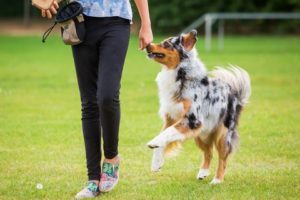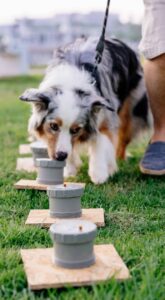
The Australian Shepherd breed is known for being extraordinarily hardworking and friendly. They learn quickly and love to play. The dogs also have a reputation for being kind and loyal.
What else are you looking for in a perfect pet?
Of course, when choosing this dog, there are a few critical nuances to remember.
Keep reading to learn more about Australian Shepherds.
Breed history
These dogs are widely known as Aussies. As you can understand from the name, an Australian Shepherd was first bred to herd sheep or cattle.
This herding dog was created for farm work, so it is ideally suited to life in the countryside. Due to their original mission, the dogs are hardy and well suited for farmers or ranchers.
Despite their relatively small size, they can run for about 40 miles per day,
And, despite the name, the dogs don’t come from Australia.
According to official information, the breed started on American ranches in the 19th century.
Australian Shepherd health issues
In general, Aussies are pretty healthy. However, there are a few breed-relevant health issues that future owners should bear in mind.
Here are some of the most common health concerns that can affect Australian Shepherds:
Hip dysplasia
This genetic condition causes the hip joint to develop abnormally. If not treated properly, it can lead to arthritis and lameness.
Elbow dysplasia
Like hip dysplasia, this genetic condition causes the joint to develop abnormally leading to arthritis and lameness if not treated properly.
Vision problems
This breed also commonly suffers vision problems, and puppies with two copies of the blue Merle gene are at higher risk of being deaf or blind.
Progressive Retinal Atrophy (PRA)
This genetic condition causes the retina to degenerate over time, leading to blindness.
Collie Eye Anomaly (CEA)
This genetic condition affects eye development, leading to vision problems.
Epilepsy
First of all, Australian Shepherds are known to develop epilepsy more than any other breed.
Unfortunately, epilepsy is difficult to diagnose, and treatments can cause side effects.
Autoimmune Diseases
Australian Shepherds are prone to several autoimmune diseases, including autoimmune thyroiditis, which can cause hypothyroidism, and systemic lupus erythematosus, which can affect multiple organs.
Cancer
Like all dog breeds, Australian Shepherds are susceptible to various forms of cancer, including lymphoma and hemangiosarcoma.
Regular veterinary check-ups and a healthy diet can help keep your Australian Shepherd healthy.
Provide a healthy diet
Regarding feeding and nutrition for Australian Shepherds, providing a well-balanced diet is essential to support their high energy levels and overall health. Here are some key points to remember:
High-quality dog food
Choose a high-quality dog food specifically formulated for active breeds. Look for options that list meat as the first ingredient and avoid foods with excessive fillers and artificial additives.
Protein
Australian Shepherds benefit from a diet rich in high-quality animal protein. Look for dog foods containing lean protein sources, such as chicken, turkey, or fish.
Balanced nutrition
Ensure your Australian Shepherd’s diet includes protein, carbohydrates, fats, vitamins, and minerals. A balanced diet is essential for their overall health and well-being.
Portion control
Australian Shepherds are prone to weight gain, so you must monitor their food intake and avoid overfeeding. Follow the recommended portion sizes based on your dog’s weight and activity level.
Regular feeding schedule
Establish a regular feeding schedule to provide structure and routine for your Australian Shepherd. Most adult dogs do well with two meals daily, while puppies may require more frequent feeding.
Fresh water
Always provide access to clean water to keep your Australian Shepherd well-hydrated, especially during active periods.
Avoid harmful foods
Certain human foods can be toxic to dogs, so it’s important to avoid feeding your Australian Shepherd chocolate, grapes, raisins, onions, garlic, and foods containing xylitol, an artificial sweetener also known as birch sugar.
Grooming
Aussies have double coats, which makes them water-resistant. The hair is medium in length and curly or wavy. The bred sheds, so be prepared to clean up a lot of hair and brush your dog often.
While some experts say you can get by with weekly brushing, daily brushing will help remove loose hair and reduce your amount of clean-up work.
The dogs need baths every four to six weeks, depending on their activity level. Be cautious about bathing too much to avoid drying out your dog’s skin.
You must also check and clean your dog’s ears weekly, brush its teeth daily, and trim its nails every four to six weeks.
Australian Shepherd breed characteristics
According to the ASCA (Australian Shepherd Club of America), the average size for a female is between 18 and 22 inches high, while males are slightly taller and can reach 19 to 23 inches.
The average weight is 35 to 70 pounds. In addition to these general characteristics, it is also nice to know when Australian shepherds stop growing, which generally differs for each gender.
The range of colors in this breed is diverse. Puppies can be born in various colors and have different spots and marking patterns. The most recognized colors are red, black, and merle (blue or red/liver). Many dogs may have different combinations of white or copper marks on various parts of their bodies.
Aussies’ range of eye colors is also diverse. As a rule, they have blue or brown eyes in different shades of these two colors. However, these dogs are often heterochromatic, meaning they may have two different colored eyes.
As for their tails, most Aussies are born with long tails, although some dogs happen to have a naturally-bobbed tail instead.
The average life expectancy for medium-sized dogs is between 11 to 13 years. Most Aussies tend to live a bit longer. Their average lifespan is between 12 to 15 years.
Temperament

Aussies are known for being highly energetic, which is why they require a great deal of attention, exercise, and space.
These dogs enjoy mental and physical activity in any form. Thus, they are often good learners. However, they don’t typically adapt well to living in an apartment.
These dogs are brilliant and playful. If treated well, they are loving, kind, devoted, rewarding, and loyal.
However, they may also be cautious, guarding, and reserved since their initial mission was to work on the ranch.
Thus, Aussies may become highly protective of their property and bark warnings in reaction to suspicious activity. They are not inclined toward obsessive barking.
These dogs tend to form intense bonds with selected people. When they are devoted to their owners, they strongly desire to stay with them all the time.
As for children, Aussies get along the best with kids of eight years and older. This doesn’t mean that they don’t like kids.
On the contrary, most are very friendly to children. Sometimes, however, they may be too hyperactive for kids and can inadvertently knock them over.
Untrained or improperly trained Aussies may also nip at the heels or feet of kids to control or herd them.
Training needs
Australian Shepherds are highly intelligent and trainable dogs. However, Australian Shepherd puppies can be stubborn at times.
Therefore, it’s crucial to start training them early. Socialization, proper care, and training can help Australian Shepherds become thoughtful and intelligent companions.
This breed of dog is also very versatile and can be trained to perform different jobs, which is why many people choose to work with them regarding livestock.
Teaching Australian Shepherds tricks is easy because they are fast learners.
When training Australian Shepherds, it’s important to remember a few tips.
Firstly, start early and be consistent with your training.
Secondly, positive reinforcement techniques such as treats and praise should encourage good behavior.
Additionally, it provides plenty of socialization opportunities, as Australian Shepherds thrive on attention and interaction with people and other animals.
Lastly, keep training sessions short and engaging to prevent boredom or frustration from setting in.
With these tips in mind, you should be well on your way to successfully training your Australian Shepherd.
Additionally, training is essential for these energetic dogs because it helps keep them focused and happy.

Training challenges
Australian Shepherds are highly intelligent and energetic dogs but can also present some common behavioral challenges.
Proper training and socialization can help address these challenges and ensure a harmonious relationship between dogs and their owners.
High energy level
Australian Shepherds are known for their high energy levels. However, if they are not given enough physical and mental stimulation, they can become bored and exhibit destructive behaviors.
Regular exercise and engaging activities such as agility training, obedience training, and interactive play sessions are essential to address this challenge.
Providing puzzle toys and interactive games can also help keep them mentally stimulated.
Herding Instinct
Due to their herding background, Australian Shepherds may display herding behaviors such as nipping at people’s heels or attempting to herd other pets or children.
It’s crucial to redirect this instinct through training and provide alternative outlets for their energy, such as engaging them in activities that positively channel their herding instincts.
Separation anxiety
Australian Shepherds are known for forming strong bonds with their owners, and as a result, they can develop separation anxiety when left alone for extended periods.
To address this, gradual desensitization to being alone, creating a safe and comfortable space for the dog, and providing interactive toys can help alleviate separation anxiety.
Additionally, establishing a consistent routine when leaving and returning home can provide a sense of security for the dog.
Barking
While Australian Shepherds are not predisposed to excessive barking, due to their protective nature, they may bark to alert their owners or respond to perceived threats.
Training focused on teaching the “quiet” command and providing positive reinforcement for calm behavior can help manage excessive barking.
Socialization
Australian Shepherds need early and extensive socialization to prevent shyness or aggression towards strangers or other animals.
Exposing them to various environments, people, and animals in a positive and controlled manner from a young age can help them become well-adjusted and sociable adults.
Positive reinforcement training methods, consistency, patience, and understanding the breed’s natural instincts are key to addressing these behavioral challenges.
Seeking professional guidance from a certified dog trainer or behaviorist can also be beneficial in addressing specific behavioral issues and creating a training plan tailored to the individual dog’s needs.
Socialization needs
Training and socialization are vital for Australian Shepherd puppies to ensure they grow into well-behaved and balanced dogs.
Start training early to establish good behaviors and prevent bad habits from forming.
Australian Shepherds are intelligent and active, so mental and physical stimulation is vital.
Positive reinforcement methods, such as treats and praise, work well with this breed.
Early socialization is also crucial. Expose your Australian Shepherd puppy to various people, animals, and environments from a young age to help them become confident and well-adjusted adults.
Enrolling them in puppy classes or arranging playdates with other friendly dogs can aid in their social development.
Remember to supervise all interactions to ensure positive experiences.
Consistency, patience, and plenty of love are essential for the successful training and socialization of Australian Shepherd puppies, ensuring they become well-behaved full-size Australian Shepherds.
Exercise needs
Aussies make the best companions for active people because of their high energy levels. To vent their natural energy, they require a minimum of 30-60 minutes of exercise and two to three hours of play and attention.
If you are too busy or inactive, an Australian Shepherd may not be the right option. When these dogs don’t get enough attention, play, and exercise to vent their energy, they may get bored and become destructive!
Since it is a thoughtful breed, they can quickly develop games that often include lots of running at top speeds, thus turning the house upside down.
Mental stimulation
Australian Shepherds are highly intelligent and energetic dogs that thrive on engaging activities and mental stimulation.
To keep your Australian Shepherd happy and healthy, providing plenty of opportunities for physical exercise and mental challenges is important.
Australian Shepherds benefit from agility and obedience training, herding activities, and interactive games such as fetch, Frisbee, nose work, and hide-and-seek.
These activities not only provide physical exercise but also stimulate their sharp minds. In addition to physical activities, mental stimulation is crucial for Australian Shepherds.
Puzzle toys, interactive feeders, and treat-dispensing toys are excellent ways to engage them mentally.
Teaching them new tricks and providing them with tasks that require problem-solving skills can also help satisfy their need for mental stimulation.
Regular training sessions can also help keep their minds sharp and provide them with the mental challenges they crave.
Australian Shepherds excel in obedience training, agility training, and even advanced tricks due to their high intelligence and eagerness to please.
Remember that Australian Shepherds thrive on attention and interaction with their owners. Participating in activities can strengthen your bond while providing the mental and physical stimulation they need to thrive.
Australian Shepherd grooming needs
Australian Shepherds have a thick and dense double coat, which requires regular grooming to keep it clean and healthy.
They shed moderately throughout the year but heavily twice yearly during shedding season.
Grooming an Australian Shepherd entails a few steps, including:
Brushing
Australian Shepherds require frequent brushing to prevent matting and tangling of their fur. Brushing their coat two to three times a week helps remove loose hair and dirt.
Bathing
Bathe your Aussie occasionally, preferably every three months or when they get dirty. Over-bathing can strip their coat of natural oils, leading to dry skin and hair.
Nail trimming
Trimming their nails regularly, ideally every two to three weeks, is essential to prevent overgrowth and discomfort.
Teeth cleaning
Tooth decay and gum disease are common in dogs, so it is crucial to brush their teeth regularly or provide dental chews and toys.
Ear cleaning
Australian Shepherds are prone to ear infections, so it is essential to clean their ears weekly using a damp cotton ball or a soft cloth.
Where to get an Aussie?

If you have decided that an Australian Shepherd is the right dog for you, you can buy a puppy from a breeder or get a dog from a rescue.
In the first case, we recommend seeking a responsible and reputable breeder.
Getting an Aussie from a rescue is also a brilliant idea.
Don’t know where to start?
We have collected some options, including Australian Shepherd Rescue Midwest, PetFinder, Australian Shepherd Rescue, and New Spirit 4 Aussie Rescue.
Final words
So, how can you know if Aussie is the right dog for you? Take the time to analyze your available time and energy.
Although they may seem hyperactive and cause trouble if bored, Australian Shepherds are incredibly kind and loving. They bond tightly with their owners and are known for their loyalty.
Thus, they are perfect life companions who will protect and reward those who treat them right.
Also, these intelligent dogs learn quickly and are fun to play with.
Thus, an Australian Shepherd is the right choice if you are ready to give a new friend lots of love and attention.
Rachel Tomlin is an American journalist and blogger. Since her student years, Rachel has been published in various newspapers and journals of different spheres and subject matters. Each new topic in her up-to-date article is attentively researched and investigated. From politics to the current tendencies of college, papers-everything is correctly described in all her materials. Moreover, Rachel’s blog is trendy among youth, the government, and other layers of society. Rachel is currently working at essayservice.com,
